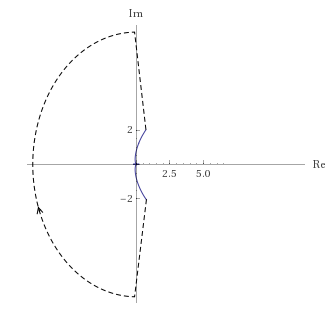The open-loop transfer function
$$G(s)=\frac{2s-11}{s(s^2+s+1)}\tag{1}$$
given in your question has the following Nyquist plot:

which is different from the one in your question.
Note that in any case it's important to know how the trace is closed, i.e., how the points $\omega=0^-$ and $\omega=0^+$ are connected. In this case they are connected by a semi-circle with infinite radius in the left half-plane (the dashed curve in the figure below):

[generated with WolframAlpha].
This is a consequence of the pole of $G(s)$ at $s=0$.
The Nyquist criterion is actually simpler than you made it look in your question. The number of clockwise encirclements ($N$) of the point $-1+j0$ equals the number of right half-plane zeros of $1+G(s)$ ($Z$) minus the number of right half-plane poles ($P$):
$$N=Z-P\tag{2}$$
Since $G(s)$ has no poles in the right half-plane ($P=0$), the number of clockwise encirclements equals the number of zeros in the right half-plane. From the Nyquist plot we see that $N=1$, so there is one zero in the right half-plane, which corresponds to one pole of the closed-loop transfer function in the right half-plane. Consequently, the system is not stable.
This is also easily verified by directly computing the poles of the closed-loop transfer function
$$Q(s)=\frac{G(s)}{1+G(s)}=\frac{2s-11}{s^3+s^2+3s-11}\tag{3}$$
roots([1,1,3,-11])
ans =
-1.2833 + 2.3182i
-1.2833 - 2.3182i
1.5667 + 0.0000i
which shows that there is one pole with a positive real part, as predicted from the Nyquist plot.



